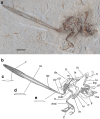A Mesozoic bird from Gondwana preserving feathers
- PMID: 26035285
- PMCID: PMC4458891
- DOI: 10.1038/ncomms8141
A Mesozoic bird from Gondwana preserving feathers
Abstract
The fossil record of birds in the Mesozoic of Gondwana is mostly based on isolated and often poorly preserved specimens, none of which has preserved details on feather anatomy. We provide the description of a fossil bird represented by a skeleton with feathers from the Early Cretaceous of Gondwana (NE Brazil). The specimen sheds light on the homology and 3D structure of the rachis-dominated feathers, previously known from two-dimensional slabs. The rectrices exhibit a row of rounded spots, probably corresponding to some original colour pattern. The specimen supports the identification of the feather scapus as the rachis, which is notably robust and elliptical in cross-section. In spite of its juvenile nature, the tail plumage resembles the feathering of adult individuals of modern birds. Documentation of rachis-dominated tail in South American enantiornithines broadens the paleobiogeographic distribution of basal birds with this tail feather morphotype, up to now only reported from China.
Figures


References
-
- Hou L., Martin L. D., Zhou Z. & Feduccia A. Early adaptive radiation of birds: evidence from fossils from northeastern China. Science 274, 1164–1167 (1996). - PubMed
-
- Foth C. On the identification of feather structures in stem–line representatives of birds: Evidence from fossils and actuopalaeontology. Palaeontol. Z 86, 91–102 (2012).
-
- Kurochkin E. N. A true carinate bird from Lower Cretaceous deposits in Mongolia and other evidence of Early Cretaceous birds in Asia. Cret. Res 6, 271–278 (1985).
-
- Sanz J. L. et al. An Early Cretaceous bird from Spain and its implications for the evolution of avian flight. Nature 382, 442–445 (1996).
Publication types
MeSH terms
LinkOut - more resources
Full Text Sources
Other Literature Sources

